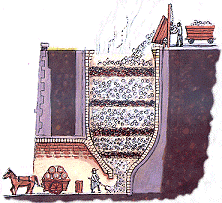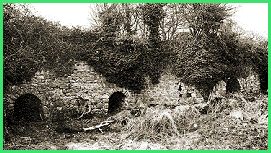Limekilns near
Llanymynech
Photograph
thanks
to Peter Kirkman's
Montgomery Canal
website
(See top right)


| Delivering lime for the fields | |||
|
Drawing
by
Rob Davies |
The Montgomeryshire
Canal was built mainly to help the county's agricultural
output by transporting lime for fertilising the land. |
|
|
Limekilns near Photograph
thanks |
 |

|
|
Limekiln
remains on the Brecon and Abergavenny Canal |
 |
Limestone
was broken into lumps with heavy hammers, then mixed with coal and fed into
the top of the kilns, which acted like an oven or furnace. The lime which was produced was removed from an opening at the bottom of the kiln at the back of a short tunnel. Horse drawn carts could then load up with lime for local delivery or for transfer to a canal barge. |
|
The lime in the form in which it
came from the kilns could be a dangerous
cargo to carry, especially if it came
into contact with water (see right).
This was why limekilns were built at many places alongside the canal,
so that the resulting lime would not have to travel very far either by
boat or by wagon. Back to Montgomeryshire Canal menu
|
|
||
|
RDR
|